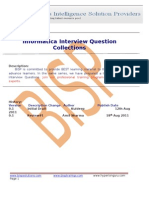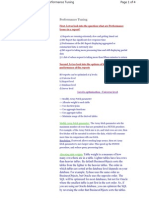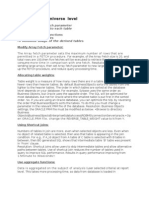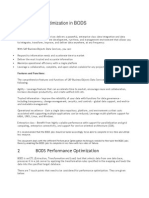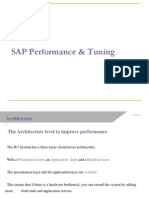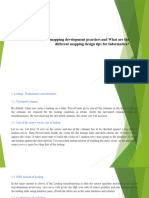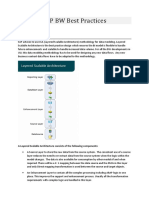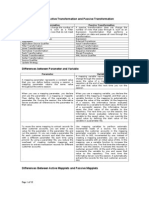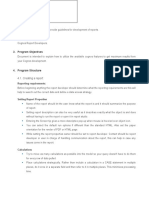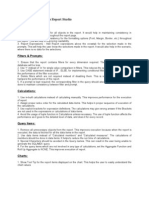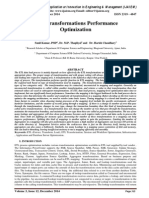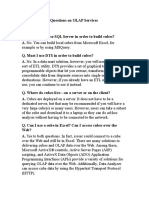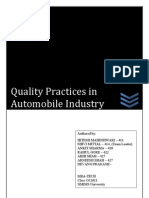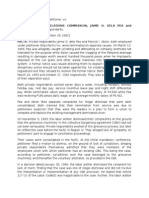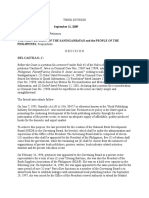Performance Tuning: Level 1 Optimization - Universe Level
Performance Tuning: Level 1 Optimization - Universe Level
Uploaded by
Nikki GongiCopyright:
Available Formats
Performance Tuning: Level 1 Optimization - Universe Level
Performance Tuning: Level 1 Optimization - Universe Level
Uploaded by
Nikki GongiOriginal Title
Copyright
Available Formats
Share this document
Did you find this document useful?
Is this content inappropriate?
Copyright:
Available Formats
Performance Tuning: Level 1 Optimization - Universe Level
Performance Tuning: Level 1 Optimization - Universe Level
Uploaded by
Nikki GongiCopyright:
Available Formats
Performance Tuning BO reports can be optimized at 4 levels: a) Universe level b) Report level c) Database level d) Server level Level
1 optimization - Universe level -> Modify Array Fetch parameter -> Allocate weight to each table -> Use shortcut joins -> Use aggregate functions -> Use aggregate tables -> Minimize usage of the derived tables Modify Array Fetch parameter: The Array fetch parameter sets the maximum number of rows that are permitted in a FETCH procedure. For example, of the Array Fetch size is 20, and total rows are 100, then five fetches will be executed to retrieve the data, which will consume more time in comparison with one fetch. Resolution: If network allows sending large arrays, then set Array fetch parameter to new larger value. This speed up the FETCH procedure, and reduce query processing time. Allocating table weights: Table weight is a measure of how many rows there are in a table. Lighter tables have less rows than heavier tables. By default BusinessObjects sorts the tables from the lighter to the heavier tables. The order in which tables are sorted at the database level depends on your database. For example, Sybase uses the same order as BusinessObjects, but Oracle uses the opposite order. The SQL will be optimized for most databases, but not for Oracle where the smallest table is put first in the sort order. So, if you are using an Oracle database, you can optimize the SQL by reversing the order that BusinessObjects sorts the tables. To do this you must change a parameter in the relevant PRM file of the database. Resolution: Business Objects settings, the ORACLE PRM file must be modified as below: Browse to directory Business Objects\BusinessObjects Enterprise 6\dataAccess\RDBMS\connectionServer\oracle. Open ORACLE.PRM file, change the REVERSE_TABLE_WEIGHT value to N from Y. Using Shortcut joins: Numbers of tables in join are more, even when selected objects are less. Even when no object of related table is selected, then also that table is appearing in the join condition. For e.g., If A_id object from A table of C table is selected with B table in between, then BO generated SQL shows that intermediate table B table was present in From clause.
Resolution: Shortcut joins allow users to skip intermediate tables and allow alternative paths between tables. Use of shortcut join reduces the number of tables used in query to improve SQL performance. Results in query performance improving from 1.5 minute to 30 seconds!! Use aggregate functions: Data is aggregated on the subject of analysis (user selected criteria) at report level. This takes more processing time, as data from database is loaded in temporary memory and then aggregated or processed to display. Resolution: Use aggregate functions (e.g., sum, count, min, max) in measure objects at universe level. Aggregate functions will aggregate the data at database level rather than at report level which will save on processing time at report level and also reduce the number of rows returned back to report. Creating and using aggregate tables: Aggregate data are obtained by scanning and summarizing all of the records in the fact table at real-time which consumes more time. Resolution: Aggregate tables contain pre-calculated aggregated data. Using aggregate tables instead of detail tables enhances the performance of SQL transactions and speeds up query execution. Aggregate_Awareness function has ability to dynamically re-write SQL to the level of granularity needed to answer a business question. Aggregate tables allow for faster querying speed and increases query performance manifolds!! Minimize usage of derived tables: Since derived tables are evaluated and executed at runtime, SQL tuning is not possible. Resolution: Minimize the usage of derived tabled and replace them with tables or materialized view. SQL tuning techniques such as creating index can be applied on tables or materialized views which will improve performance of BO reports.
Level 2 optimization - Report level -> Opt for Refresh At- Will over Refresh-On-Open -> List of Values (LOV's) -> Conditional Objects -> Complex Calcualtion in ETL -> Minimize usage of Report variables/formulas Opt for Refresh At- Will over Refresh-On-Open: Refresh-on-open reports refresh new data each time it is opened. Connection with database is established each time report is refreshed which in turn slows the report performance. Resolution: If report is based on snapshot data and static, it is better to publish report without refresh-on-open property. Users will thus view the same instance of report without establishing database connection, which will reduce the response time of BO report.
List of Values (LOV's): When we create LOV object, distinct values are selected into it. DISTINCT forces an internal sort/compare on the table. Selecting a distinct list on large table is not optimal e.g., selecting a distinct list of custom_store against t_curr_tran_daily table is not optimal. Resolution: a. Re-map the object list of values to smaller look up tables. b. If there are no smaller lookup tables, then create external file as a source to LOV. This file needs to be exported along with universe and be available to all users, which is additional overhead. Usage of external file replaces the need of lookup table and delivers high performance and weighs down the overhead cost c. Avoid creating LOV on dates and measures. Disassociate LOV from all such objects which are not display as prompts. Universe Condition Objects: The entire data from database is fetched (<=maximum rows setting) and the filters are applied at the report level. As data is not restricted at the database or universe level, the reports takes more time to execute. Resolution: When handling huge data, one of the following steps can be taken to limit data: 1. Use prompts to restrict data selection at universe level. Preferably use time period prompts in reports. 2. Replace report filters with Universe condition objects, if possible. Usage of conditional objects will limit rows returned at database level. Complex Calculations: The data from database is fetched and then calculations are applied to that data. As calculations are performed at universe or report level on huge data, reports takes more time to execute. Resolution: When dealing with huge data warehouses perform complex calculations at ETL level. Thus Business Objects saves time on calculations and deliver high performance. Minimize usage of Report variables/formulas: If the report is pulling tons of data, doing loads of joins, making lot of clever calculations, using lot of report variables and formulas, report may run very slow. Report variables and formulas are loaded and calculated in memory at real time. As variables are created at real time and calculations are performed at report level, reports takes more time to execute. Resolution: When dealing with big reports, minimize usage of report variables/formulas and try to place them at universe to deliver high performance reports. Level 3 optimization - Database level Examine the execution plan of SQL: Determine the execution plan of BO generated SQL in target database. EXPLAIN PLAN is a handy tool for estimating resource requirements in advance. It displays execution plans chosen by Oracle optimizer without executing it and gives an insight on how to make improvements at database level. Level 4 optimization - Server level
If the performance of system deteriorates when reports are accessed by larger number of users over web, then fix the problem at fourth level i.e., server level (Level 4). -> Scalable System -> Event Based Scheduling -> Report Server/Job Server closer to database server -> Maximum Allowed Size of Cache -> Minutes Before an Idle Connection is closed -> File Polling Interval in Seconds -> Maximum Number of Downloaded Documents to Cache -> Oldest On-demand Data given to a Client
You should gather the following info from client For Universe: Business Process, its flow What is the source of universe i.e. OLAP or OLTP Database details (like tables, cardinality Relationship, values, aggregate tables details) How the data is stored in DB from process flow E-R Diagram Object mapping details, formulas for creating objects if any, object names, class names
For Report: Report object details Formula details which is used in report if any Report Layout includes report headers, font size, logo, position of logo, etc. Report Types
Types of connection
There are three types of connections namely Secured, Shared and Personal. A secured connection is used to centralize and control access to sensitive or critical data. It is the safest type of connection for protecting access to data. A shared connection is used to access common resources such as universes or documents. Several users can thus use it. A personal connection is specific to one user and can be used only from the computer on which it was created.
Mode
Standard mode - able to access users only within that group Extended mode - to allow the group supervisors access to users outside their own group(s) so that they can add or remove users to their own groups, then you can do so by setting Scope Management to Extended Mode.
Secured mode - restrict the access of specific users to specific commands. the general supervisor by default uses the Secured mode of operation.
You might also like
- THE STEP BY STEP GUIDE FOR SUCCESSFUL IMPLEMENTATION OF DATA LAKE-LAKEHOUSE-DATA WAREHOUSE: "THE STEP BY STEP GUIDE FOR SUCCESSFUL IMPLEMENTATION OF DATA LAKE-LAKEHOUSE-DATA WAREHOUSE"From EverandTHE STEP BY STEP GUIDE FOR SUCCESSFUL IMPLEMENTATION OF DATA LAKE-LAKEHOUSE-DATA WAREHOUSE: "THE STEP BY STEP GUIDE FOR SUCCESSFUL IMPLEMENTATION OF DATA LAKE-LAKEHOUSE-DATA WAREHOUSE"Rating: 2 out of 5 stars2/5 (2)
- Database Administration (SQL Server)Document43 pagesDatabase Administration (SQL Server)Nayd-aYan Arevir100% (1)
- BISP Informatica Question CollectionsDocument84 pagesBISP Informatica Question CollectionsAmit Sharma100% (2)
- All in One Informatica QuestionnaireDocument83 pagesAll in One Informatica QuestionnaireRamasundari Vadali75% (4)
- The UPLB 2018 BSCS CURRICULUMDocument5 pagesThe UPLB 2018 BSCS CURRICULUMJiejhay JiipieNo ratings yet
- First, Let Us Look Into The Question What Are Performance Issues in A Report?Document24 pagesFirst, Let Us Look Into The Question What Are Performance Issues in A Report?Amit SethiNo ratings yet
- Performance Tuning.Document51 pagesPerformance Tuning.pavansuhaneyNo ratings yet
- BO Universe Performance-TuningDocument4 pagesBO Universe Performance-TuningAndrew YeungNo ratings yet
- Universe Level OptimizationDocument2 pagesUniverse Level OptimizationPraveen XavierNo ratings yet
- A Interview Questions and Answers - Cool InterviewDocument30 pagesA Interview Questions and Answers - Cool Interviewcm_ram847118100% (16)
- A Interview Questions and AnswersDocument34 pagesA Interview Questions and Answersmallekrishna123No ratings yet
- How To Improve Performance of Sap Bods JobsDocument2 pagesHow To Improve Performance of Sap Bods JobssatishNo ratings yet
- Informatica Performance TuningDocument35 pagesInformatica Performance TuningPriyankaNo ratings yet
- Performance Optimization in BODSDocument67 pagesPerformance Optimization in BODSisskumar67% (3)
- SAP Performance TuningDocument38 pagesSAP Performance Tuningmukesh100% (1)
- Informatica Best PracticesDocument4 pagesInformatica Best Practicesrishabh_200No ratings yet
- 70-450: Pro:Microsoft Desktop Support ConsumerDocument78 pages70-450: Pro:Microsoft Desktop Support ConsumerSubramanian KNo ratings yet
- Interview Questions HarshaDocument4 pagesInterview Questions HarshaHarsha VardhanNo ratings yet
- SAP Performance & Tuning: Bonus Material For 201 ABAP Interview Questions Material Code: BM02Document38 pagesSAP Performance & Tuning: Bonus Material For 201 ABAP Interview Questions Material Code: BM02nandha587yNo ratings yet
- Informatica Interview Questions and AnswersDocument5 pagesInformatica Interview Questions and AnswersPreethaNo ratings yet
- What Are The Best Mapping Development Practices and What Are The Different Mapping Design Tips For Informatica?Document29 pagesWhat Are The Best Mapping Development Practices and What Are The Different Mapping Design Tips For Informatica?Prudhvinadh KopparapuNo ratings yet
- SAP BW Performance OptimizationDocument11 pagesSAP BW Performance OptimizationHemanth JanyavulaNo ratings yet
- Data Stage PDFDocument37 pagesData Stage PDFpappujaiswalNo ratings yet
- Performance Optimization TechniquesDocument4 pagesPerformance Optimization TechniquesAmarnathMaitiNo ratings yet
- SAP Performance TuningDocument36 pagesSAP Performance Tuningindian_sagaNo ratings yet
- Informatica Power Center Best PracticesDocument8 pagesInformatica Power Center Best Practicesrishabh_200No ratings yet
- SAP BW System AdminDocument9 pagesSAP BW System AdminNelson RajaNo ratings yet
- Query Processing and Optimization in Oracle RDB: Gennady Antoshenkov, Mohamed ZiauddinDocument9 pagesQuery Processing and Optimization in Oracle RDB: Gennady Antoshenkov, Mohamed ZiauddinEbaybookNo ratings yet
- SQL LectureDocument23 pagesSQL LectureJai PrakashNo ratings yet
- Oracle Database Administration ContentsDocument98 pagesOracle Database Administration ContentsVijayasarathi Dharmaraj100% (1)
- Oci Tuning DsDocument37 pagesOci Tuning DsNaresh KumarNo ratings yet
- Powercenter Server On Windows Can Connect To Following Databases: Ibm Db2 Informix Microsoft Access Microsoft Excel Microsoft SQL Server Oracle Sybase TeradataDocument9 pagesPowercenter Server On Windows Can Connect To Following Databases: Ibm Db2 Informix Microsoft Access Microsoft Excel Microsoft SQL Server Oracle Sybase Teradatavpv0002No ratings yet
- Before Tuning Goldengate: Online RedoDocument8 pagesBefore Tuning Goldengate: Online RedoRahul NaikNo ratings yet
- Performance Tuning OverviewDocument33 pagesPerformance Tuning Overviewmagi9999No ratings yet
- A Interview QuestionDocument15 pagesA Interview QuestionprasadrkkNo ratings yet
- IM Ch11 DB Performance Tuning Ed12Document17 pagesIM Ch11 DB Performance Tuning Ed12MohsinNo ratings yet
- Paper Infa Optimization PravinDocument14 pagesPaper Infa Optimization PravinBhaskar ReddyNo ratings yet
- DAC Interview QuestionsDocument5 pagesDAC Interview QuestionsPoornima SrivenkateshNo ratings yet
- BW Best PracticesDocument8 pagesBW Best Practicesjay normousNo ratings yet
- Differences Between Active Transformation and Passive TransformationDocument18 pagesDifferences Between Active Transformation and Passive TransformationLakshmanan VenugopalNo ratings yet
- Datastage InterviewDocument161 pagesDatastage Interviewmukesh100% (1)
- Informatica Best PracticesDocument28 pagesInformatica Best PracticeszipzapdhoomNo ratings yet
- Guidelines For Report Development in CognosDocument5 pagesGuidelines For Report Development in CognosArpit AgrawalNo ratings yet
- Framework Manager Terminology For InterviewDocument9 pagesFramework Manager Terminology For InterviewgoodflowNo ratings yet
- Best Practices Report Studio GeneralDocument16 pagesBest Practices Report Studio Generalsubhabratapati_238No ratings yet
- SQL DBA QuestionDocument4 pagesSQL DBA Questionsirisha715No ratings yet
- ETL Transformations Performance OptimizationDocument7 pagesETL Transformations Performance OptimizationInternational Journal of Application or Innovation in Engineering & ManagementNo ratings yet
- Demantra Performance TuningDocument4 pagesDemantra Performance TuningchandanjeeNo ratings yet
- SQL Server Performance Tuning Interview QuestionsDocument12 pagesSQL Server Performance Tuning Interview Questionsmahesh100% (1)
- Did You Look at The Execution Time of The Data Provider?Document4 pagesDid You Look at The Execution Time of The Data Provider?A Suresh BabuNo ratings yet
- Questions On OLAP ServicesDocument11 pagesQuestions On OLAP ServicesppavandsNo ratings yet
- SQL Server 2014 Development EssentialsFrom EverandSQL Server 2014 Development EssentialsRating: 4.5 out of 5 stars4.5/5 (2)
- The Informed Company: How to Build Modern Agile Data Stacks that Drive Winning InsightsFrom EverandThe Informed Company: How to Build Modern Agile Data Stacks that Drive Winning InsightsNo ratings yet
- How To Develop A Performance Reporting Tool with MS Excel and MS SharePointFrom EverandHow To Develop A Performance Reporting Tool with MS Excel and MS SharePointNo ratings yet
- M39t1 Remote Keyless Entry and Anti-Theft System PDFDocument2 pagesM39t1 Remote Keyless Entry and Anti-Theft System PDFLuis MarquezNo ratings yet
- SAP Warehouse Management-Configuration - Control CycleDocument10 pagesSAP Warehouse Management-Configuration - Control CycleAnonymous evI2pu100% (1)
- The Levelof Satisfactionofthe Studentsofthe Universityofthe Immaculate Conceptionon School CanteenDocument16 pagesThe Levelof Satisfactionofthe Studentsofthe Universityofthe Immaculate Conceptionon School CanteenLadyjoy GardoceNo ratings yet
- Lilian Paul Ngatola CVDocument2 pagesLilian Paul Ngatola CVlilianpaul673No ratings yet
- Bhagat Co BankDocument57 pagesBhagat Co BankSyaape100% (1)
- Primer On Vegetable Gardening PDFDocument216 pagesPrimer On Vegetable Gardening PDFNorman Rodriguez LlorandoNo ratings yet
- Geran Ur13 Zgo-04-05-Xxx Vamos Feature Guide (v4) - v1.0Document44 pagesGeran Ur13 Zgo-04-05-Xxx Vamos Feature Guide (v4) - v1.0Muhammad Haris0% (1)
- Financial Services Knowledge Series On Ifrs 17 General Measurement Model Volume IIDocument21 pagesFinancial Services Knowledge Series On Ifrs 17 General Measurement Model Volume IIMohammad IslamNo ratings yet
- Quality Management and Practises in Automobile SectorDocument57 pagesQuality Management and Practises in Automobile Sectorshivi73100% (16)
- Deutz CatalogDocument252 pagesDeutz Catalogsgarbossadevis71100% (1)
- Ar 2019 Annual Report DojDocument66 pagesAr 2019 Annual Report DojNeanderthalNo ratings yet
- Political Law 2017 Bar ExaminationsDocument5 pagesPolitical Law 2017 Bar ExaminationsShane EdrosolanoNo ratings yet
- Nexo Ps15-r2 DatasheetDocument2 pagesNexo Ps15-r2 DatasheetChing Tsz Pan0% (1)
- 5422160319Document308 pages5422160319MadhaviNo ratings yet
- Do Soil Compaction Test Results Over 100% Mean Over-CompactionDocument9 pagesDo Soil Compaction Test Results Over 100% Mean Over-CompactionTraineeNo ratings yet
- Módulo 1 - emDocument16 pagesMódulo 1 - emEduardo e Elen PereiraNo ratings yet
- Lee Filters - System-OverviewDocument8 pagesLee Filters - System-OverviewAlejandro ContrerasNo ratings yet
- Understanding Wireshark: First Packet in A Conversation. Part of The Selected ConversationDocument7 pagesUnderstanding Wireshark: First Packet in A Conversation. Part of The Selected Conversationbros07No ratings yet
- Natural HazardDocument7 pagesNatural HazardMerry Pableo HinedoNo ratings yet
- SAP Ariba Supplier - RiskDocument2 pagesSAP Ariba Supplier - RiskalanchungNo ratings yet
- 1932 Greene County First Sectional Basketball ProgramDocument12 pages1932 Greene County First Sectional Basketball ProgramlintonhistoryNo ratings yet
- StarBus - UTC Online 4.0Document1 pageStarBus - UTC Online 4.0Rakesh PanwarNo ratings yet
- Simulasi Vending Machine Dengan Mengimplementasikan Finite State AutomataDocument7 pagesSimulasi Vending Machine Dengan Mengimplementasikan Finite State AutomataSinggih PramanaNo ratings yet
- PowerEdge R750X - C1Document16 pagesPowerEdge R750X - C1AmericoNo ratings yet
- Atlas Farms Inc Vs NLRCDocument3 pagesAtlas Farms Inc Vs NLRCCazzandhra BullecerNo ratings yet
- Question On IFRS 9Document1 pageQuestion On IFRS 9Chitradevi RamooNo ratings yet
- Javier v. Sandiganbayan, 599 Scra 324 (2009)Document13 pagesJavier v. Sandiganbayan, 599 Scra 324 (2009)Rogie ToriagaNo ratings yet
- Tamil Keyboard Layout For Bamini FontDocument1 pageTamil Keyboard Layout For Bamini Fontrscm7522920% (1)
- Like Elon Musk An in Complete Guide Business Lessons From The Greatest Entrepreneur of All Time Michal Adam DominiczakDocument17 pagesLike Elon Musk An in Complete Guide Business Lessons From The Greatest Entrepreneur of All Time Michal Adam DominiczakVed KananiNo ratings yet


